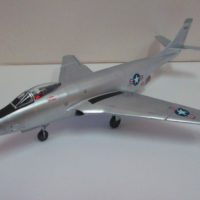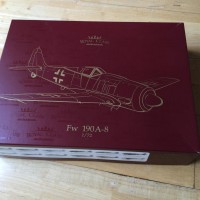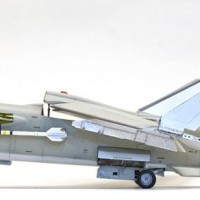Spad VII C1, 1:32, Roden, Adj. Didier Masson, 124 Esc. 1 victory
The SPAD S.VII was the first successful design of a series of biplane fighters produced by the Société Pour L'Aviation et ses Dérivés (SPAD) during the First World War. Like its successors, the S.VII was renowned as a sturdy and robust aircraft with good climbing and diving characteristics. It was also a stable weapons platform, although pilots used to the more maneuverable Nieuport fighters found it difficult to control. A number of famous aces flew on it, such as the Frenchman Georges Guynemer, the Italian Francesco Baracca and the Australian Alexander Pentland.
The French Aviation Militaire was sufficiently impressed with the performance of the SPAD V prototype to order a batch of 268 aircraft on 10 May 1916. However, initial problems soon arose and it took several months for the SPAD VII to enter service in significant numbers. at the front, the last aircraft from the original batch was delivered only in February 1917.
Despite these delays, some aircraft were delivered to front-line units as early as August 1916 to complement the Nieuport fighters. By this date the Nieuport 11s, which ended the infamous "Fokker Disaster" episode, had largely been replaced by later types such as the Nieuport 17, but these were now surpassed by a new generation of German fighters in the second half of 1916 that threatened to put Germany back in charge above the sky. At the same time, rotary engines, which had powered most Allied fighters up to that point, proved difficult to expand further, while heavier in-line engines were becoming increasingly powerful. In this context, it was hoped that the new Hispano-Suiza 8-powered SPAD VII would be able to fight the latest German fighters under better conditions. The first aircraft delivered to the frontline unit was an S.112 flown by Lt Sauvage of N.65, followed by an S.113 assigned to Georges Guynemer of N.3. Guynemer already had 15 victories to his credit at the time, but it was Armand Pinsard of N.26 who claimed the aerial victory on 26 August.
The introduction of the SPAD VII was not enough to change the balance of the air war, but it allowed pilots and mechanics alike to familiarize themselves with the new fighter. Many pilots found the SPAD to lack maneuverability and some even reverted to the more nimble Nieuports. A new speed-based tactic was developed to take advantage of the SPAD's power and compensate for its lack of maneuverability. The aircraft's ability to safely dive at speeds of up to 400 km/h (250 mph) allowed the pilot to break away from combat when the situation called for it.
After solving the initial problems and dividing production between several manufacturers, the SPAD VII was finally available in large numbers at the front in early 1917. By mid-1917 there were about 500 in the front line, largely replacing the Nieuport. He gained a reputation for being stronger than his predecessors. Its major shortcoming was its armament of one machine gun at a time when enemy Albatros D.III fighters were equipped with two. The SPAD VII was gradually replaced by the improved SPAD XIII for front-line units, but remained in use as a training aircraft with the Aviation Militaire throughout the war and remained the standard pilot certification test aircraft until 1928.
Didier Masson (23 February 1886 – 2 June 1950) was a pioneering French aviator. He was born in Asnières, France. He died and was buried in Mérida, Yucatan, Mexico. His adventures included his life as a pioneer barnstormer, being the second aviator in history to surface bomb a warship, as well as combat service in the Lafayette Escadrille with Edwin C. Parsons and Charles Nungesser. In one of history's more unusual aerial victories, Masson shot down an enemy plane after his own plane's engine stopped running. Later in life he was a manager of the pioneering Pan American World Airways and also a French consular official.
Masson was working as an instructor for Martin in California when Agent Venustiano Carranza hired him to become a mercenary soldier. Masson contracted with the Mexican revolutionary leader for $5,000 as an aircraft purchase fee, an allowance of $750 for equipment costs, a $300 monthly salary, $50 per flight per flight in Mexico, and at least $250 for each aerial bombing flight. Masson piloted a push plane purchased from Glenn Martin in 1912 and smuggled into Mexico via Arizona. The armed smugglers who forced their way into Mexico at the Nogales crossing included Masson and his mechanic, as well as Carranza's subordinate Captain Joaquín Bauche Alcalde.
The name of the aircraft was Sonora. It could carry two people or one person and 150 lb (68 kg) of bombs. After Masson's reconnaissance flight over Guaymas Harbor, he and Bauch used the aircraft to attack the Federalist gunboats for the first aerial bombardment of a surface ship. On 10 May 1913, Masson and Bauche flew over at least five Mexican gunboats and dropped four improvised pipe bombs containing 15 kg (33 lb) of explosives. They missed, but the gunboats, thought defenseless, sailed away from Guaymas harbor to safety; indeed, some of the crew jumped overboard in panic caused by the explosions. Masson also flew an unknown number of subsequent bombing missions.
Masson's Mexican adventure ended when Masson quit flying for the Mexican revolutionaries on August 5, saying that he had not been paid for a month and that he had reservations about bombing cities. Masson returned to his newly adopted United States.
On September 8, 1914, Masson re-enlisted in his old unit. After being briefly transferred to the 36eme Regiment d'Infanterie, Masson began military pilot training in Pau. On 10 May 1915, he obtained his Military Pilot's Brevet at Caudron. He was then assigned to Escadrille 18, which served the Caudrones. In September 1915, he completed further training, learning to fly Nieuports. He was then transferred to the Nieuport squadron, Escadrille 16, in April 1916 and passed through to begin briefing at Cazeau on the 16th. He sat in this assignment for only two months, on June 16, 1916, he enlisted in the famous Lafayette Escadrille, Escadrille N124. Although he never became an ace, Masson managed the remarkable feat of having his Nieuport 17 knocked out in a fight with traffic and still managing to shoot down his German opponent, before gliding to safety near the French front lines. His hasty exit from the crashed plane saved him from German artillery fire falling on him. By the time Masson left N124, he was adjutant.
The Spad VII kit from Roden is a very good basis for building a decent model. As I knew from Tom Cleaver's review that the engine cannot be closed when installing the engine, so I designed the build with an open engine from the start.
I cut out all the cooling holes in the engine fairing. Unfortunately, I stored the side panels so well that I wouldn't lose them, I couldn't find them again. So I made a new mesh one like some Spads used in the hot summer months. I made and added some details in the engine and cockpit and again used fishing line for the lines. Propeller as usual made of wood. Shades mixed from Revell colors and painted on with a brush. I didn't want to make the swastikas with decals, so I painted them by hand so that they would copy a bit of hand painting in field conditions. The color of the canvas doesn't match the Spades on display in museums, but I stuck to a template from a 40 year old modeling magazine. Hope you like it, thanks for watching.















Very nice SPAD. It is one of my favorite WW1 fighters.
Is a bit jarring to see Swastikas on an Allied plane (that aren't kill markings) but it was an ancient religious symbol.
Unfortunately, Hitler discredited this symbol, but at the time it was a fairly frequently used symbol on both sides. Masson is said to have taken it from the buttons of Indiana's headband.
Nice SPAD.
The symbol has a long tradition all over the world. A lesser known fact is that the international boy scout movement used it well in to the 30s https://loamisland.kennedyscouts.org.au/scouts-history/the-swastika/#:~:text=what%20ever%20the%20origin%20was,entitles%20him%20to%20the%20help
Excellent job and a very interesting scheme, Milan!
Thanks friend.
Very nice work and a great result, Milan.
Thank you Tom.
Milan, it is now my pleasure to compliment you on your work; this is a lovely rendition of a Spad and your skills are certainly in evidence with this excellent finish.
I did laugh when you mentioned you'd stored the side panels so well, you couldn't find them again, the sort of thing I can well relate to!
Very well done in completing this kit to such a high standard... ;-).
Thank you, I am very pleased to receive praise from a person who has elevated modeling to art. I am more of a collector than a model maker, but I try to make my models at least a little closer to the originals.
Lovely SPAD! I usually find missing parts immediately after I finish fabricating new ones.
Thank you Robert, exactly. That's the modeling law of approval.
A great rendition of the Spad Milan, I was wondering when we would see some more of your excellent work and research, Masson led quite an adventurous life.
Thank you Ian. The next one will be in a few weeks.
A lovely SPAD VII and interesting bio of Masson.
Thank you Chas.
Milan Tesař (@milantesar)
This is a magnificent build. I really like how it looks. Outstanding
I also enjoyed reading the article as well.
Thank you Louis, I'm glad.
Well done, Milan. Always enjoy your skills brought to Great War aircraft.
Thank you Gary.
That's a wonderful result, Milan @milantesar)
Also the supporting is a pleasure to read and very informative, thanks.
Thank you John.